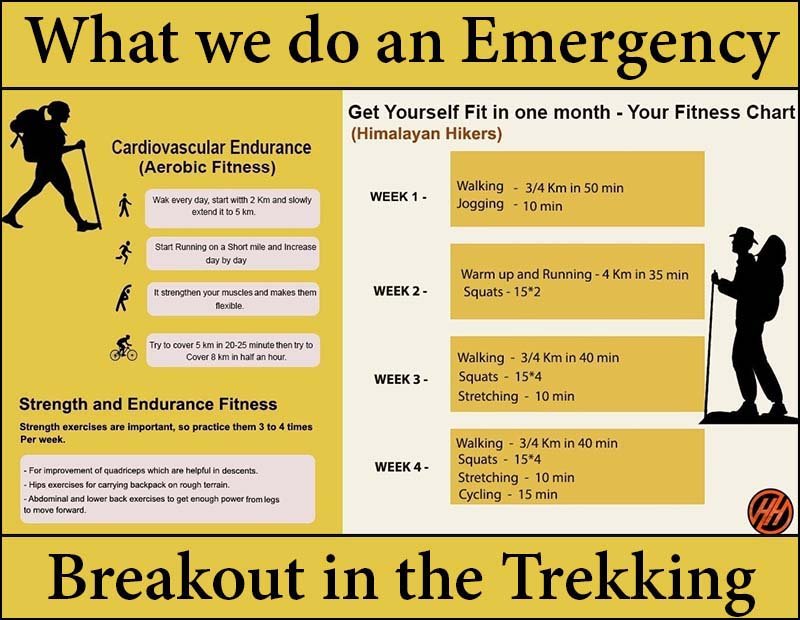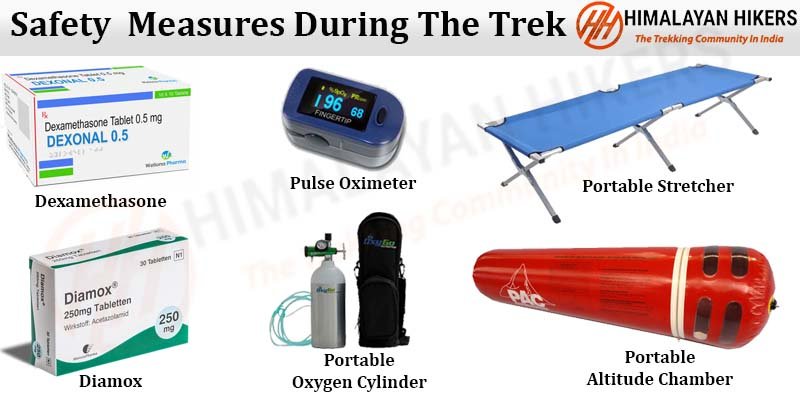
What we do during an emergency breakout in the Trekking?
Trekking in the Himalayas is not a cup of tea but it is a rewarding experience. However, it’s important to keep things in mind when it comes to Safety. One must know about the weather conditions, the altitude gain, fitness and other factors that can wreck your experience. In such adverse conditions, you are solely responsible for your well being and act maturely.
Also Read About – Safety Tips For Safe Trekking.
Preparations before the Trek
You’ve to understand that treks are away from cities and medical help is not always easily available. So, if you are heading for an adventurous trekking trip, stick to certain trekking guidelines and tips. Following these simple tips will help make the trek more fun and experiential for you as well as your fellow trekkers.
These tips and guidelines cater to useful and requisite information about your fitness training, packing and health precautions to be taken before and during the trek.
1. Firstly, when you start, target 5 km in 40 minutes
2. Then gradually increase your pace by running at least 4 times a week. Then try to bring it down to 5 km in less than 37 minutes
3. If you are a person who prefers cycling over running then your target must be 22 km means you should be able to cover 22 km in 60 minutes.
3. Walking is a great exercise that gives great shape to your legs and your body. It helps in burning calories and cut down excess weight and strengthens the heart.
4. Jogging is effective in increasing the human lifespan and makes your lungs stronger. It is an aerobic activity that requires a lot of oxygen. This is a great exercise for fighting obesity and staying healthy.
5. Squats are the best form of functional exercises to improve stability. They also strengthen your legs, thighs, hips, and hamstring.
6. Another great cardiovascular exercise is pushing your body upstairs after stairs. This is regarded as the best exercise for increasing strength and power
Also Read About – Things To Carry On A Trek.
Instructions before the trek
A medical checkup before the trek: One should be very serious this checkup. Open up about your health issues, trekking experiences, health conditions and other ailments.
Medical fitness checkup should include
1. Chronic diseases, if you are suffering from heart diseases, epilepsy
2. Blood pressures: Resting a heart rate of fewer than 100 beats/minutes
3. Someone having a history of illness and drug allergies
4. The overall fitness should and health condition should be good.
What to pack
Warm clothes, sleeves, wind shelter, comfortable clothing, and extra warm clothes so that you can enjoy trekking. A raincoat is the necessary
Footwear: A well-fitted trekking footwear shoes are highly recommended. If you wear an uncomfortable pair of shoes, your feet will be hurt.
Also Read About – Get Yourself Physically Fit For a Trek

During the trek
It is important to stay hydrated and keep drinking water at regular intervals (Minimum 4 liters a day is essential)
It is important to have a proper meal, especially in the mountains. Your body requires a lot of energy hence proper diet is crucial, especially carbohydrate content.
Walk slowly and steadily
While reaching the campsite, you are not supposed to sleep but take a walk around especially in the Himalayas. Enjoy and cherish every moment.
Drinking Alcohol is not allowed in the Trekking
In case the trekkers are feeling uncomfortable or having a headache do not hide, inform the trek leaders.
When trekking in the high altitude, do not discourage other trekkers, always motivate your fellow trekkers.
What Himalayan hikers can do during an emergency breakout: Safety Measures?
Himalayan Hikers have been ascertained a name in the trekking industry when it comes to safety and taking precautions during an emergency outbreak. Emergency bottled oxygen on all treks are made necessary by Himalayan Hikers and using pulse oximeter in order to test pulse ad oxygen saturation levels. In case of severe illness, we transfer the trekkers to the nearest hospitals in an ambulance and we arrange to walk back and arrange the stretchers in the nearest road. In any case, the trekkers have a severe health issue, we try to arrange a helicopter as we have support from the government of Uttarakhand.
Himalayan Hikers Team carry a High-altitude medical kit in every team, it has all the essential emergency medications that are required for high altitude treks. These medicines will save your life.
Trekking is always from city life and medical help is not easy to get it. When heading for an adventurous trip sticking to trekking guidelines and tips are mandatory. These are some of the simple tips which cater to useful information about fitness training, packing and health precautions for the trekkers that must be taken before and during the trek.

Safety measures from the Himalayan Hikers
1. The medical kit including Diamox and Dexamethasone for Acute mountain sickness
2. Carrying a portable oxygen cylinder
3. Stretcher
4. Carrying Altitude Chamber: for the treks which are higher than 16,000 feet.
Read About – Safe Trekking Tips for Trekkers.
Rescue plans alternatives for Trekkers Safety
In case of emergencies, when a trekker has a severe illness, even at lower altitudes, we arrange to walk back with a stretcher to the nearest road and then transfer to the nearest hospital in an ambulance (108).
Helicopter rescue: In extreme cases, we try our best to arrange for a helicopter rescue. If we get enough support from the authorities from Uttarakhand and Himachal Pradesh.
AMS – Acute Mountain Sickness
What is AMS?
Acute mountain sickness is a form of mountain sickness when you ascend quickly at a rate of more than 500m per day. AMS can be hit if your body hasn’t adapted to the height, hence it is advised to acclimatize yourself and get used to the height.
Symptoms of altitude sickness
The symptoms can be noticed about 6- 24 hours once you have arrived at a place. You may notice symptoms of altitude sickness about 6 to 24 hours depending upon your walking speed and how fast you are ascending.
1. These are the symptoms
2. Trekkers have a headache
3. Feeling sick or vomiting
4. Losing appetite
5. Feeling dizzy
6. Having difficulty in sleeping
Why does it occur?
It usually occurs when your body doesn’t get enough oxygen and thus the trekkers hit AMS.
Trekking in high altitude Himalayas is at lower pressures and lower oxygen levels. A few individuals cannot withstand this change which leads to AMS. There is no difference in gender or age.
How to control AMS?
Observe yourself. Climb slowly, you must acclimatize your body and do not push yourself further. If you think you haven’t acclimatized, walk around the campsites and do not trek further.
Speak up: Always inform the trek leaders if you are feeling sick, having dizziness or fatigue.
Do not downplay your symptoms.
Descend: If you are having severe health issues, descend quickly as instructed by the trek leader. Our company will give you medications to ease your symptoms but descending will solve the problem
If AMS is not controlled
AMS in more severe form can lead to fluid build-up in the lungs (HAPE) and in the brain (HACE) which usually affects at extreme altitude.
Remember: Do not ignore AMS, life is more important than challenging yourself to go on treks. There is always a next time. You must descent and void trekking further, even if you are having mild symptoms.
